
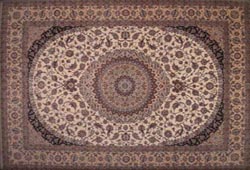 |
Nain
Rug |
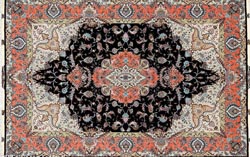 |
Trabriz
Rug |
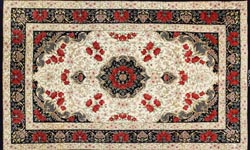 |
Qum
Rug |
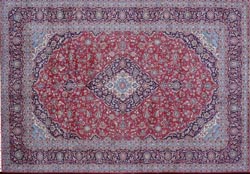 |
Kashan
Rug |
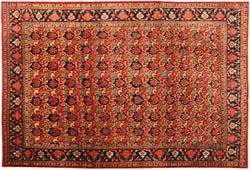 |
Bijar
Rug |
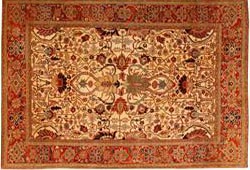 |
Turkish
Rug |
 |
Turkmenistan
Rug |
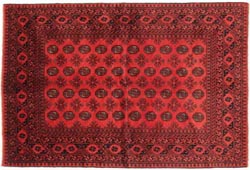 |
Afghanistan
Rug |
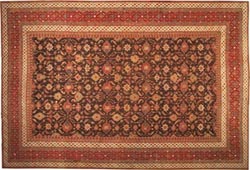 |
| Indian
Rug |
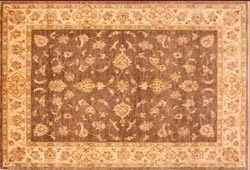 |
Pakistan
Rug |
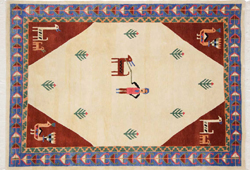 |
Nepalese
Rug |
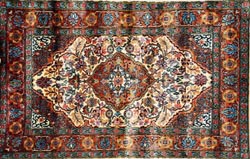 |
Kashmir
Rug |
|
| Oriental
rugs made in different countries |
Persian
hand-made carpets
Despite many presumptions it remains unknown, when the Persian
carpet emerged. The first knotted carpets, discovered in the
4th and 5th B.C., were not of Persian origin. It can be supposed
that the technique of knotting was brought to the country with
the invasion of the Seljuks in the 11th century. There is also
no knowledge about individual development stages until the beginning
of the golden period in the 16th century. From miniature painters
we know how beautiful the carpets of this period were. It can
be supposed that the great creations, generated in the time
of the Saffavid Dynasty The Saffavids not only founded a new
multinational state, but also began with the founding of famous
court manufactories in Isfahan, Tabriz, Kerman, and Kashan.
During the end of the 17th century, and even more so in the
18th century, symptoms of decline became evident affecting the
entire art and culture of Persia. The political weakening of
the country at the end of the Saffavid Dynasty and the Afghan
occupation (1721 - 1722) were causal for the symptoms of the
decline.
The feeble style of the products of the 18th century mirrors
a period of continuous wars. The growing demand in the Occident
led to a perceptible boost in the 19th century. Especially the
carpet dealers in the Basars of Tabriz carried on a thriving
export business with Europe. Numerous carpet shops were established,
operated by English firms (Ziegler 1883), German and American
enterprises. Especially the “Ziegler carpet” received an unbelievable
renaissance at this time. Persian rugs share honors with Chinese
porcelain as the two greatest Asian contributions to gracious
living in Europe and the America. The major modern-day weaving
areas in Persia are Tabriz, Kashan, Mashed, Kerman and Hamadan.
High quality rugs are generally produced in Isfahan, Nain, Qum,
Bijar and Tabriz.
Isfahan:"Isfahan is half the world"
or so the Old Persian saying would have us believe. For centuries
Isfahan rugs have been treasured both in the East and in Europe
and America. Isfahan experienced its Golden Age in the seventeenth
century when Shah Abbas, who was the king of Persia at that
time, declared it the nation's capital. The finest carpets in
the world were produced here during this period. The ancient
Persian kings always had these rugs placed throughout their
palaces floors, and sometimes hung on the walls like priceless
paintings. Isfahan itself is a very historic city, and it is
responsible for a great portion of the reputation that the Persian
rug name has today. Modern-day Isfahan rugs are made from kurk
wool. They are woven on a silk warp and weft. Isfahan rugs are
considered the best Persian rugs in the world. Typical of Isfahan
are graceful flowers and jewel-like medallions with Shah Abbas
palmettes and curving leaves, all entwined with flowing tendrils
and curving arabesques. There exist in the world today, many
antique Isfahan rugs that cost several hundreds of thousands
of dollars.
Nain: Although Nain is not a very old rug-weaving
city, it is well established and among the most valued carpet-producing
centers in Iran. It has adapted most of its skills from the
very ancient and neighboring city of Isfahan. Among the finest
carpets in the world the Nain name alone sells this rug. The
city of Nain is located in central Iran about 60 miles east
of the enchanted city of Isfahan. These rugs mainly use a perfect
ratio of silk and wool.
Qum: Qum is famous for making the best silk
Persian rugs. Qum rugs are among the finest handmade carpets
in the world. The quality of an authentic Qum rug is extraordinary;
therefore, prices tend to be much higher than those made elsewhere
(with the exception of Isfahan, Nain, Tabriz and a few other
fine rug producing centers in Iran).
Bijar: Bijar rugs are also called "Iron
rugs of Persia." Perhaps the toughest and most durable
rug on the face of the earth, the Bidjar does more than just
look pretty. These hand-woven Persian rugs are made by Kurdish
people in Northwestern Iran in the town of Bidjar. Bijar rugs
are highly esteemed for their pile thickness, structural strength,
and great weight. They are often imitated but never duplicated
because no other region uses the wet loom technique that the
particular makers of this rug use. The wet loom technique is
constantly keeping the wool, warp, and weft wet during the long
process of weaving, so the materials temporarily shrink to allow
tighter weaving, and then expand when the rug is complete and
dry to make the piece very dense and strong. Because of their
incredible durability, these rugs are ideal for high traffic
areas such as a main foyer or kitchen, but they also look astounding
in a living or dining room.
Tabriz: Tabriz rugs are among the most beautiful
and legendary Persian carpets ever built. Tabriz is an ancient
city in North Western Iran and it is probably responsible for
producing the largest percentage of all Persian rugs. There
can be many different unique designs but most of the time the
pattern in a Tabriz rug is filled with dense floral motifs,
with large palmettes, vases, foliage, and small flowers and
garden elements scattered with wild profusion. The quality is
exceptional in Tabriz made carpets. Many colors can be seen,
such as burgundy, red, and ivory and different creams, baby
or navy blue, tan, or green. There can be rugs of this type
with a medallion, and geometric designs are also seen sometimes.
Tabriz has sub-styles as well. The Mahi is probably one of the
most elegant rug designs in the world. It consists of very small
intricate fish like elements scattered neatly throughout the
many borders and medallions of the carpet. The colors are usually
dark and silk is often used in conjunction with the wool to
accentuate the highlights of the rug. The city of Tabriz is
eminent around the world because of its incredibly rich history.
Turkish hand-made carpets
Handmade carpets were possibly brought by the Seljuk people
to Asia Minor. When the Venetian merchant, Marco Polo, came
to the former capital, the city of Konya, in the year 1283,
he wrote, that there he found the most beautiful and exquisite
carpets of the world.
With the support of the Ottoman sultans, who at this time already
greatly appreciated art, the first court manufactories were
founded. From the 14th to the 17th century the most precious
court carpets were then made. These are still used as models
by many weavers until today. The so-called “Holbein carpets“,
repeatedly portrayed in his paintings, are from this period.
Great collections of the Ushak carpets and Lotto carpets dated
from the 16th and 18th century, as well as the Siebenbürge carpets.
In the following century products from Turkey were at the top
of world trade, and Smyrna became the epitome for the Oriental
carpet. As in other countries of origin, various kinds of carpets
are produced in Turkey, from the robust carpet made by the nomads,
to the rural products of Anatolian farmers, up to the finest
manufactured carpets of sheer silk. Among the finest works in
knotting next to the manufacture carpets from Hereke are the
carpets from Panderma, Istanbul, Kayseri, and Sivas. They all
enjoy traditional fame. No subject book on carpets is without
descriptions and pictures of antique carpets from Ushak, Kula,
Smyrna, Bergamo, Milas, Ghiordes, Konya, and Ladik. As of today
carpets are still made using handed down patterns
Since many generations the nomads of Anatolia make colorful,
small Yürük carpets. Yürük means wandering shepherd and is used
as generic term for all carpets of this genre. The Anatolien
Kurd carpets are also the products of nomads. They are darker
and more restrained in their coloring though. The high pile
is typical. Here the carpets are mostly used for protection
from the cold. The important provinces are arranged by alphabet
and can be found on the map.
Caucasus hand-made rugs
Arabic historians and travelers from the 8th to the 13th century
have left numerous reports about Caucasian carpets, and it seems
clear, that the art of weaving must be the most ancient in this
rough region. Historically and ethnically the Caucasus with
its almost 350 tribes and circa 150 dialects presents a very
interesting region. Even though in this melting pot of culture
various ethnic groups live together, certain stylistic uniformity
in their products remains.
It is assumed, that the Turk people or the Armenians have brought
the art of knotting to them. The rough mountain climate, in
which healthy and durable mountain sheep deliver outstanding
wool, and the isolation of the inaccessible mountain world were
the ideal conditions, under which the traditional patterns could
be preserved for the unusual Caucasians with their strictly
ordered geometrical patterns accommodating the current spirit
of the times. Exceptions to this are the now famous roses, and
flower patterns of the Karabagh and Seichur, which have originated
most likely due to the Francophilic inclinations of Russian
officers. Predominantly knotted with the Turkish knot, the Caucasian
productions impress mainly by their stark coloring and lustrous
wool. Experts can also distinguish these carpets by touch.
Dense, heavy, almost shaggy rugs are knotted by these mountain
people. Mainly the Kazakh and the Karabagh are counted among
them. Most densely knotted are the Leshgiars from Dagestan,
and with a low clip they are firm and sturdy. In the region
around the Caspian Sea and in the Mogan steppe, where the climate
is milder and the country side is more delightful, finer and
short-clipped carpets with bright varied colors and a great
pattern variety are found.
Turkmenistan hand-made rugs
Without doubt carpets were made in Turkmenistan since unknown
times, even so,due to the seclusion of this region, there is
no certain knowledge of carpet making before 1800.
With the mobility of the nomadic tribes, their constant migrations
and reorganizations it is impossible to attempt to describe
their history, especially since there are no written records
available. It is known, that in the 6th century the Turcoman
people of Turkmenistan came from the Altai Mountains, penetrating
continuously in southern direction, until, in the 10th century,
they reached the shore of the Caspian Sea. The separation of
the Turcoman people into the most important, big tribes took
approximately until the year 1600.
The environment of these countless tribes stretched from the
Caspian Sea in the East to deep into China (Chinese Turkmenistan)
and into Mongolia. The most important tribes are the Jomudes
on the river Artek, the nomadic Ersari in the Bokhara region,
and in the oasis of Achal and Merv the Tekke are found.The tribes
of Saryk live in the country side around Merv, as also the Salors.
Almost every tribe has sub-tribes with their own name. With
the more then thousands of years strife between the Turcoman
people it is all the more surprising, to find that their customs,
their culture and their artisan ability has remained uniform,
being especially expressed in the art of carpet weaving. All
Turkoman tribes love red, the basic motives are always so called
Güls (rose), which according to each tribe, has been adapted
into various forms. Formerly these expressive carpets were exclusively
made on horizontal looms, meanwhile at least the families who
have become settled, use vertical looms also.
Woven utensils of all kinds accompany the Turcoman people from
the cradle to the grave. The floor of their tents is decorated
with the large main carpet. Kibitka braids adorn the walls and
as an entry covering the Engsi is found. Pouches of all sizes
along the tent walls take the place of furniture. In these Tshowals
clothes and supplies are stored and can remain there during
their migration. Smaller pouches, so-called Torba‘s complement
the assortment. On special occasions horses and camels are decorated
with carpets and plaids, saddle bags, called Eyerlik, and these
are next to the camel pack bags, the Churdji, or the head dress.
Osmolduk is important utensil of the nomad tribes. Special meaning
has the Namazlik the prayer rug. Generally the Turkmenistan
carpet can be divided into three groups: in the first and finest
group are the Tekke, also called Bokhara, the Achal-Tekke and
the Pendeh. This group includes approximately 3/4 of all carpets
produced in Turkmenistan. As a rule, they are decorated with
Bokhara or Salor-Gül.
Afghanistan hand-made carpets
The geographical term Afghanistan does not at all concur with
the name of the carpet. The majority of the so-called Afghan
carpets“are made by the Turkoman tribes, the Ersari, Saryk,
Salor, Tekke, and their sub-tribes. Several of these nomad tribes
populate the north and northwest of Afghanistan, though the
majority lives in Turkmenistan and Usbekistan, and even in the
outer northeast corner of Iran. All of them make the same kind
of carpet - the Afghan. But in the remaining areas of Afghanistan
carpets are also produced, for example in Daulatabad, Karkinin,
and other places. In part the different descriptions name the
province of origin, but sometimes the name stands for the motif,
or for a certain quality.
Afghan carpets are mostly of a dark, heavy red. In the center
are big octagons, so called Güls (=rose), which sometimes can
have a diameter of up to 30 cm. Mostly they are knotted in a
Turkish knot, only a few manufactory products, for example from
Daulatabad or Mazari-i-Sharif, show a Persian knot. Overall
in this country the horizontal loom is used.
Indian hand-made carpets
In the humid climate of this multinational state, carpets did
not play an important role at first. In the 16th century the
Mogul rulers, who were very fond of Persian art, brought in
famous weaving craftsmen from Persia, to be in charge of their
newly founded court manufactories. Magnificent carpets for the
imperial palaces were created. Only later a particular Indian
style developed.
In1600s an increase in production was caused by the English,
who became by and by the rulers in India. By the hostile take-over
through the British crown in the 19th century the final unification
of the torn country was made possible. The grand Indian Empire,
the cradle of the 3 great world religions, the Hinduism, Buddhism,and
Sikhism, later broke apart into Pakistan, India Sikhism, Bhutan,
Bangladesh, and Burma.
In Germany the Indian carpet played only a minor role up until
the middle of 1950s. In the surge of the postwar Wirtschaftwunder
a reasonably priced fashion article was created with the Indo-Hamadan,
which became a convincing success. In the entire country of
India new weaving manufactories were established. The scope
of products was increased; the Persian carpet was copied and
put on the global market in uncounted variations.
Four main centers with very differing products must be mentioned:
Kashmir, Djaipur, Agra, and Benares.
Kashmir, most likely the oldest of the weaving areas - today
produces finest carpets in the Persian style, made of wool,
but often also of artificial or natural silk. The capital Srinagar
is the collecting and trading point for the attractive products.
Jaipur, the former residence of powerful maharadjahs, has a
long tradition of artisans and make especially delicate wool
carpets. The province with the most important production of
wool, has so made a name for itself Jaipur
Agra, with the most beautiful building of the world, the Tadj
Mahal, is also a capital of modern carpet production. The East
India Carpet Company made die Indian Sarough acceptable and
founded the newer knotting tradition.
Benares, at the Ganges River, known as holy city to the Hindu
pilgrims, is located in the largest knotting area of India.
Three cities: Bhadhoi, Khamaria, and Mirzapur have manufactories
that produce carpets of exceptional quality for worldwide export.
In Indian productions, the carpets are always dealt in foot
measures and the density of knots is determined by inch. Conversion
formulae can be found in the chapter “Mark of Quality and Conversion”.
Indian carpets profited enormously by the American embargo against
the Iran. Their copies of Persian carpets were attractive in
their composition, satisfactory in quality, and acceptable in
price. India was first to recognize the great demand for “uniform
goods“. Patterns, sizes, and qualities were standardized and
catalogued. Due to this, new forms of marketing were made possible.
Not only the traditional carpet dealers, who as experts until
then sold precious individual pieces as work of art, determined
the market, but also increasingly the department stores and
furniture shops. Big marketing campaigns of similar carpets
made enormous turnovers possible, therefore reaching new target
groups.
Pakistan hand-made carpets
In the time of the Mogul rulers, in the 16th/17th century, Lahore
was already a centre of the weaving art. Persian master craftsmen
helped the manufactories to great fame. Mostly it was Moslem
weavers, which came from the bordering countries, Afghanistan,
Iran, or from Kashmir, bringing their designs with them.
After the separation of the country, mainly due to religious
reasons, the country won its independence from the British Empire
in 1947. A renaissance of the knotted carpet is last but not
at least due to the Moslem weavers who came into the country
after the division. Today Pakistan carpet productions are an
important commercial factor. The carpets are made in family
workshops as well as in manufactories, and the rural people
still play a big role in this industry.
Pakistan and India share 400 year history of carpet-weaving.
In 1947 the British granted independence to the Indian subcontinent
and Pakistan was created from the northwest areas of India.
The major factor in the partitioning was religion, Pakistan
being Moslem and India being Hindu. After the partition, many
Moslem weavers moved from India to Lahore and other parts of
Pakistan. These weavers were the foundation of the rug-weaving
industry of the new country of Pakistan. Turcoman designs are
frequently used in Pakistan rugs. Modern weaving center are
Lahore, Karachi and Peshawar.
Nepalese hand-made carpets
The highland of Tibet is the actual home of the so-called Nepal
carpets. When Tibet was declared “Autonomic Territory of the
Peoples Republic of China“ in 1959, not only their worldly leader,
the Dalai Lama, but also many Tibetans fled the country to the
neighboring countries. At that time the International Red Cross
and the Swiss government started an aid programme, allowing
Tibetan refugees to do in their new home. That was the start
of the carpet production in the Kingdom of Nepal. At the beginning
the designs and coolers of the old originals had to be adapted
to contemporary tastes. The sparing design and the coloring
in pastel shades met the taste of the customers. Young people
were noticeably enthusiastic about this modern style Oriental
carpet.
New designs and collections continued to come out. Customer
designed patterns were converted with the help of computers
and then produced. With the use of silk, new textures were created.
Numerous catalogues were published, giving the Nepal an exceptional
popularity.
|